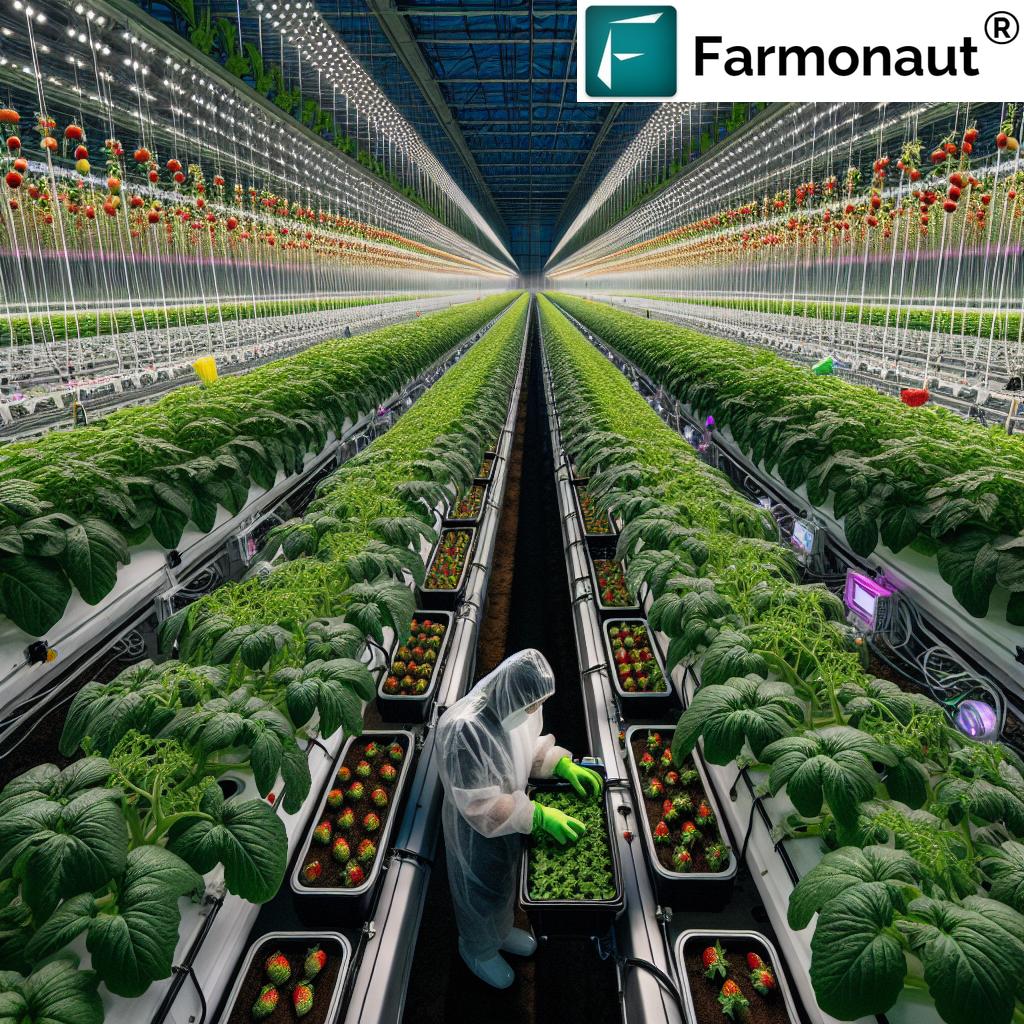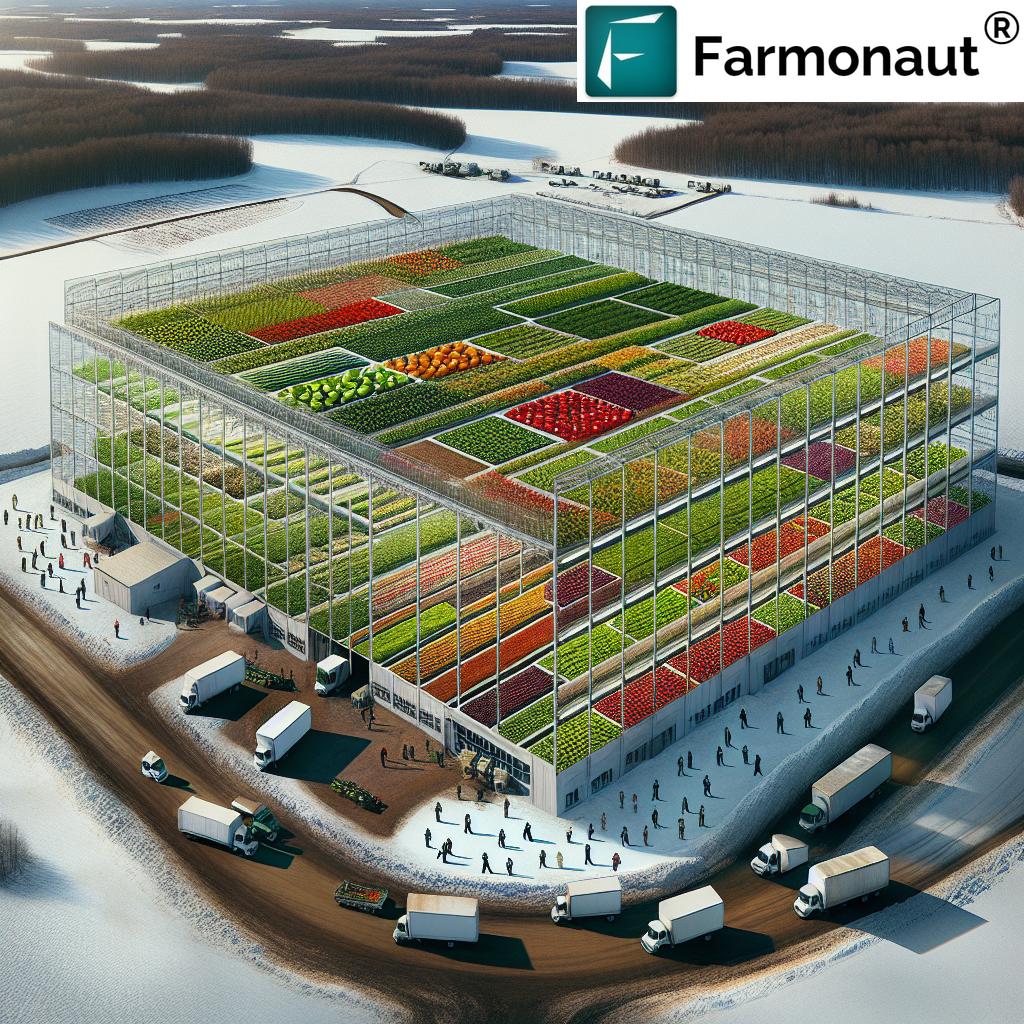Revolutionizing Ontario’s Greenhouses: Top 2024 Trends in Controlled Environment Agriculture
“Ontario’s greenhouse industry is adopting over 50 new biological solutions for pest management in 2024.”
As we delve into the cutting-edge world of controlled environment agriculture (CEA) in 2024, we’re witnessing a remarkable transformation in the way we grow food. Ontario’s greenhouses are at the forefront of this revolution, embracing innovative technologies and sustainable practices that are reshaping the future of agriculture. In this comprehensive exploration, we’ll uncover the top trends that are revolutionizing the greenhouse industry, from advanced pest management strategies to year-round production techniques.
At Farmonaut, we’re excited to be part of this agricultural evolution. Our satellite-based farm management solutions are helping growers across North America optimize their operations and boost productivity. As we examine the latest developments in greenhouse technology, we’ll also highlight how our platform is contributing to the advancement of precision agriculture.
1. Integrated Pest Management: A Biological Revolution
One of the most significant trends we’re observing in Ontario’s greenhouses is the widespread adoption of integrated pest management (IPM) strategies. This approach combines biological, cultural, and chemical methods to control pests and diseases while minimizing environmental impact.
- Biological control agents: Beneficial insects and microorganisms are being introduced to combat harmful pests naturally.
- Pheromone traps: Advanced monitoring systems use insect pheromones to detect and track pest populations.
- Precision application: Targeted pesticide use reduces overall chemical inputs and protects beneficial organisms.
Growers are increasingly turning to agricultural biological solutions as a cornerstone of their IPM strategies. These eco-friendly alternatives to traditional pesticides are not only effective but also align with consumer demand for sustainably produced food.

2. Year-Round Vegetable Production: Breaking Seasonal Barriers
Year-round vegetable production is no longer a futuristic concept but a present reality in Ontario’s greenhouses. Advanced climate control systems, supplemental lighting, and innovative growing techniques are enabling growers to produce fresh, high-quality vegetables regardless of the season.
- LED lighting: Energy-efficient LED systems provide optimal spectrum and intensity for plant growth.
- Vertical farming: Multi-level growing systems maximize space utilization and increase yields.
- Hydroponics and aeroponics: Soilless growing methods optimize nutrient delivery and water usage.
These advancements are particularly beneficial for crops like tomatoes, cucumbers, and lettuce, which are now available fresh from local sources throughout the year. This trend not only enhances food security but also reduces the carbon footprint associated with long-distance transportation of produce.
3. Premium Berry Varieties: A Sweet Success in North America
The cultivation of premium berry varieties is emerging as a lucrative trend in North American greenhouses. Growers are focusing on developing and producing high-quality strawberries, raspberries, blackberries, and blueberries that offer superior flavor, texture, and shelf life.
- Genetic innovation: New berry varieties are bred for improved taste, disease resistance, and yield.
- Controlled microclimates: Precise environmental control allows for optimal growing conditions year-round.
- Extended growing seasons: Greenhouse cultivation enables berry production well beyond traditional harvest periods.
This trend is particularly significant in regions like Ontario, Quebec, and the Maritimes, where outdoor berry seasons are typically short. By leveraging CEA technologies, these areas are becoming key players in the North American berry market.
4. Greenhouse Technology Advancements: Smart Solutions for Modern Growers
Greenhouse technology advancements are revolutionizing every aspect of CEA. From climate control to crop monitoring, these innovations are enhancing efficiency, productivity, and sustainability.
- AI-powered climate control: Machine learning algorithms optimize temperature, humidity, and CO2 levels in real-time.
- IoT sensors: Connected devices provide continuous monitoring of plant health and environmental conditions.
- Robotics and automation: Automated systems for planting, harvesting, and packaging reduce labor costs and improve consistency.
At Farmonaut, we’re proud to contribute to this technological revolution with our satellite-based crop monitoring system. Our platform provides growers with real-time insights into crop health, enabling them to make data-driven decisions and optimize resource allocation.
Explore our advanced agricultural solutions:
5. Sustainable Greenhouse Farming Practices: Eco-Friendly Growth
Sustainable greenhouse farming practices are no longer optional but essential in the modern agricultural landscape. Ontario’s greenhouse industry is leading the way in implementing eco-friendly solutions that reduce environmental impact while maintaining high productivity.
- Energy-efficient systems: Cogeneration plants and renewable energy sources reduce carbon footprints.
- Water recycling: Closed-loop irrigation systems minimize water waste and runoff.
- Biodegradable packaging: Eco-friendly materials are being used for packaging fresh produce.
These practices not only benefit the environment but also resonate with environmentally conscious consumers, creating a competitive advantage for growers who prioritize sustainability.
“Controlled environment agriculture in North America has increased tomato yields by 40% compared to traditional farming methods.”
6. Agri-Food Worker Community Events: Fostering Connection and Collaboration
The greenhouse industry recognizes the importance of its workforce, and a growing trend is the organization of agri-food worker community events. These initiatives aim to foster camaraderie, improve worker satisfaction, and enhance the overall work environment in agricultural settings.
- Cultural celebrations: Events that honor the diverse backgrounds of agricultural workers.
- Skills workshops: Training sessions to enhance workers’ skills and career development.
- Health and wellness programs: Initiatives focused on the physical and mental well-being of workers.
By investing in their workforce, greenhouse operators are creating more stable and productive work environments, which is crucial for the long-term success of the industry.

7. Market Trends: Shifting Dynamics in Fresh Produce Distribution
The distribution landscape for fresh produce is evolving rapidly, influenced by changing consumer preferences and technological advancements. Ontario’s greenhouse industry is adapting to these market trends to stay competitive and meet consumer demands.
- Direct-to-consumer models: Online platforms and subscription services for fresh greenhouse produce.
- Local food movements: Increased focus on supplying nearby urban markets with fresh, locally grown vegetables.
- Value-added products: Development of pre-packaged salads, snack-sized vegetables, and other convenience-oriented offerings.
These trends are reshaping the way greenhouse products reach consumers, creating new opportunities for growers to diversify their revenue streams and build stronger connections with their customer base.
8. Greenhouse Tomato and Cucumber Seeds: Breeding for Excellence
The development of specialized greenhouse tomato and cucumber seeds is a critical trend driving productivity in controlled environment agriculture. Seed companies are focusing on creating varieties specifically adapted to greenhouse conditions, offering improved yield, disease resistance, and flavor profiles.
- High-yield varieties: New cultivars that maximize production in limited greenhouse space.
- Disease-resistant strains: Seeds engineered to withstand common greenhouse pathogens.
- Flavor-focused breeding: Development of tomato and cucumber varieties with enhanced taste and texture.
These advancements in seed technology are enabling growers to produce higher-quality crops more efficiently, meeting the increasing demand for premium greenhouse vegetables in North American markets.
9. Controlled Environment Agriculture Solutions: Beyond Traditional Greenhouses
Controlled environment agriculture solutions are expanding beyond traditional greenhouse structures, incorporating new technologies and designs to optimize growing conditions and resource use.
- Indoor vertical farms: Multi-story growing facilities in urban areas, maximizing land use efficiency.
- Rooftop greenhouses: Integration of growing spaces on urban buildings, reducing transportation costs.
- Modular container farms: Portable growing units that can be deployed in various locations.
These innovative approaches to CEA are allowing for food production in non-traditional agricultural areas, including urban centers in Ontario and across North America. At Farmonaut, we’re excited to see how our satellite-based monitoring solutions can be adapted to these new growing environments, providing valuable insights for operators of these cutting-edge facilities.
Discover how Farmonaut can enhance your CEA operations: Explore our API
10. Regional Developments: Ontario to Quebec and Beyond
The greenhouse industry is experiencing significant growth and innovation across various regions in North America. From Ontario to Quebec, and extending into the northeastern United States and Washington State, each area is contributing unique advancements to the field of controlled environment agriculture.
- Ontario: Leading in tomato and pepper production, with a focus on energy-efficient greenhouse designs.
- Quebec: Emerging as a hub for urban agriculture and innovative CEA solutions.
- Northeastern United States: Expanding greenhouse operations to meet growing demand for locally produced vegetables.
- Washington State: Pioneering in the use of renewable energy sources for greenhouse operations.
These regional developments are creating a diverse and dynamic greenhouse industry across North America, with each area leveraging its unique strengths and resources to drive innovation in CEA.
Table: Top 2024 Greenhouse Technology Trends in Ontario
| Technology Trend | Key Benefits | Estimated Adoption Rate | Primary Crop Applications | Environmental Impact |
|---|---|---|---|---|
| Integrated Pest Management | Reduced chemical use, improved crop health | 75% | Tomatoes, cucumbers, peppers | High positive impact |
| Year-Round Production Systems | Consistent supply, higher yields | 60% | Lettuce, herbs, berries | Medium positive impact |
| Biological Solutions | Eco-friendly pest control, soil health improvement | 80% | All greenhouse crops | High positive impact |
| Smart Climate Control | Optimized growing conditions, energy efficiency | 70% | All greenhouse crops | Medium positive impact |
| Sustainable Water Management | Water conservation, reduced environmental impact | 65% | All greenhouse crops | High positive impact |
The Role of Farmonaut in Advancing Greenhouse Technology
As we explore these exciting trends in controlled environment agriculture, it’s important to highlight how Farmonaut’s innovative solutions are contributing to the advancement of greenhouse technology. Our satellite-based farm management platform offers valuable tools for growers looking to optimize their operations and stay at the forefront of agricultural innovation.
- Real-time crop health monitoring: Our satellite imagery provides up-to-date information on vegetation health, helping growers identify and address issues promptly.
- AI-powered advisory: The Jeevn AI system offers personalized recommendations based on real-time data, enhancing decision-making for greenhouse operators.
- Resource optimization: Our tools for fleet and resource management help agribusinesses streamline their operations and reduce costs.
- Sustainability tracking: With carbon footprint monitoring capabilities, we assist greenhouse operators in measuring and improving their environmental impact.
By leveraging Farmonaut’s technology, greenhouse growers can enhance their productivity, reduce resource wastage, and make data-driven decisions that contribute to the overall advancement of the industry.
Ready to elevate your greenhouse operations? Explore Farmonaut’s solutions:
Conclusion: Embracing the Future of Controlled Environment Agriculture
As we’ve explored in this comprehensive overview, the greenhouse industry in Ontario and across North America is undergoing a remarkable transformation. From advanced pest management strategies to year-round production techniques, the trends we’ve discussed are shaping the future of controlled environment agriculture.
The adoption of sustainable practices, innovative technologies, and data-driven solutions is not just improving productivity and efficiency but also addressing critical challenges such as food security and environmental sustainability. As we look to the future, it’s clear that the greenhouse industry will continue to play a pivotal role in shaping the agricultural landscape of North America.
At Farmonaut, we’re committed to supporting this evolution by providing cutting-edge satellite-based solutions that empower growers to make informed decisions and optimize their operations. Together, we can build a more sustainable and productive future for controlled environment agriculture.
Frequently Asked Questions (FAQ)
- What is controlled environment agriculture (CEA)?
Controlled environment agriculture is a technology-based approach to food production that provides protection and maintains optimal growing conditions throughout the development of the crop. - How are greenhouses in Ontario adapting to climate change?
Ontario greenhouses are implementing energy-efficient systems, water recycling technologies, and climate-resistant crop varieties to adapt to changing environmental conditions. - What are the main benefits of integrated pest management in greenhouses?
Integrated pest management reduces chemical pesticide use, promotes biodiversity, and helps maintain a balanced ecosystem within the greenhouse, resulting in healthier crops and reduced environmental impact. - How is technology improving greenhouse productivity?
Advanced technologies such as AI-powered climate control, IoT sensors, and automated systems are optimizing growing conditions, reducing labor costs, and increasing overall yield and quality of greenhouse crops. - What role does Farmonaut play in greenhouse management?
Farmonaut provides satellite-based crop monitoring and management solutions that offer real-time insights into crop health, enabling greenhouse operators to make data-driven decisions and optimize resource allocation.
For more information on how Farmonaut can enhance your greenhouse operations, visit our API Developer Docs or contact our team of experts today.






